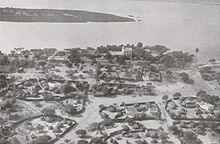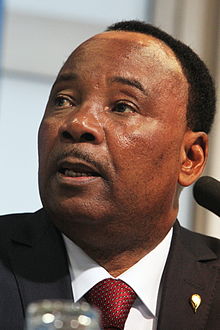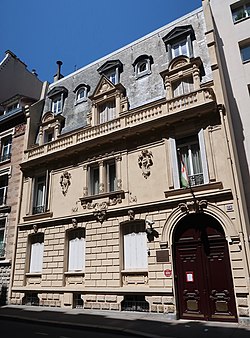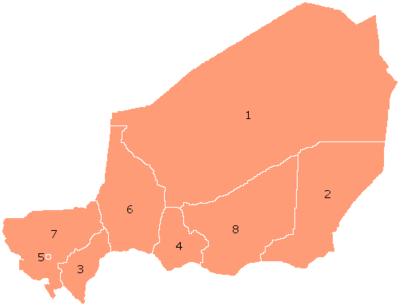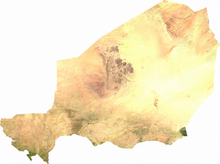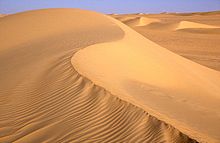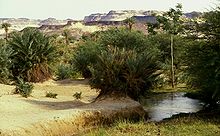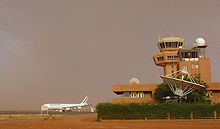Niger
Niger, officially the Republic of the Niger (in French, République du Niger), is a landlocked country in West Africa. It borders Nigeria and Benin to the south, Burkina Faso and Mali to the west, Algeria and Libya to the north, and Chad to the east. Its northern and central zones are located in the desert areas of the Sahara and the Sahel.
Niger was a European colony in French West Africa, which gained independence in 1960. Its economy is considered by some sources to be one of the most deprived in Africa, and approximately two-thirds of its population are estimated to live under the poverty threshold. Thus, its human development index in 2016 was 0.353 and, ranking 187, makes it the fourth poorest country in the world. Its democracy is unstable and it has suffered several coups d'état in recent decades, the last in February 2010, when President Tandja Mamadou was deposed after 10 years in power. Until April 2011 the country was governed by a Military Junta headed by the officer Salou Djibo, until the handover of power the winner of the 2011 elections, former President Mahamadou Issoufu.
It has an area of 1,267,000 km², and a population of 18,045,729 (2015), mostly Muslim, which is concentrated in the southern strip, particularly in the southwestern region on the banks of the Niger River. It is divided into seven departments and the district of its capital city, Niamey. It is a country rich in minerals, among which uranium stands out, a valuable product whose price, however, registers strong fluctuations. However, only 3.9% of its territory is suitable for agriculture, which added to the droughts and desertification of its territory, makes it vulnerable to famines. The government has also started exploration and development projects. exploitation of gold and oil deposits.
History
Prehistory
Nigerian territory has been inhabited by hominids for more than ninety millennia, according to the archaeological evidence found. Botanical, climatic and geological evidence indicates that at that time the desertification process of the entire northern region of the country had not yet had begun, or was incipient.
Groups that lived by herding left behind cave paintings of abundant wildlife, domestic animals, and carts, as well as a complex culture dating back to at least the 10th millennium BCE. C., who stood out for his ceramic works as well as for his technique in the development of bows and arrows. From that period there are also traces of an active hydrography, when during the Neolithic the climate became clement, and the Niger river and Lake Chad recorded their maximum levels.
Although six thousand years ago the northern regions located in the Sahara were still fertile, the desert had already advanced remarkably in present-day Niger by the 25th century BC. C.
Islamic influence
Since the early 12th century, the Tuareg built large federations, which expanded their influence south into the Air Mountains, displacing their former inhabitants further south. At its most powerful, this entity controlled present-day Niger and exerted great weight in northern Nigeria.
The Songhay Empire expanded into present-day Niger from the early 14th century, controlling as far as Agadez before its collapse in 1591, an entity of which the Zarma and Songhai peoples retain traces. After the fall, some parts of the Empire and refugees from present-day Mali formed a series of Songhai states, of which the Dendi kingdom was the most powerful.
In the 17th century, the Fulani moved into the eastern Liptako region. The small Zarma kingdoms and several Hausa states, which arrived in the 10th century and converted to Islam in the 14th, collided with the Fulani expansion of Sokoto in the south. In the 17th century they controlled the trade routes between the Mediterranean and Ghana and Nigeria. The border with British Nigeria was based in part on the break between the Sokoto Caliphate to the south, and the ruling Hausa dynasty that had left the north. In the far east, in the Lake Chad basin, the successive expansion of the Kanem-Bornu Empire empires ethnically spread the Kanuri and Toubou as far west as the 17th-century Zinder and Kaouar oases. variant:small-caps;text-transform:lowercase">X to XVII.
Arrival of Europeans
In the 19th century, contact with the West began through exploration, particularly by the naturalist Mungo Park and the German explorer Heinrich Barth, in the service of the British Empire. Indeed, the colonial powers were interested in connecting their eastern enclaves and Westerners on the African continent, so the existence of a water source like Lake Chad further intensified interest in the region.
The British and French divided the region on paper, setting the northernmost limit of the final border, which was extended by the officer Parfait-Louis Monteil in the 1890s. Although French efforts to control the region began before 1900, various groups were not subdued until 1922, when the colony was consolidated.
French colonization
French colonization took place at the end of the 19th century. Colonial forces met more opposition than they bargained for, launching the Voulet-Chanoîne punitive expedition, rampaging through the south of the country in 1898–99, leaving behind a series of atrocities. The ultimate boundary between British and French colonies was set in 1904, which followed the course of the Niger River, from Timbuktu to Lake Chad.
During their colonial rule, the French favored the Zarma ethnic group as well as practitioners of the Muslim religion, since it presented more concordance with their system than the animist indigenous structures. Some religious practices that were perceived as threatening by the administration local were in effect suppressed.
Although revolts by the Tuareg continued, after the siege of Agadez in 1916 and 1917 the French controlled the area. From then on, present-day Niger became part of French West Africa. The capital was in Dakar, Senegal, with a local governor in Niamey. In 1931 tens of thousands of people died due to a famine, which led many other inhabitants to flee to Nigeria. After a short period of prosperity, difficult food conditions returned in 1937 and 1940.
After the Brazzaville Conference of 1944, in addition to granting French nationality to the inhabitants of those territories, in 1946 the French Constitution promoted decentralization. In 1956 the colonial system tried once more to adapt itself through the Reform Law (Loi Cadre) of July 23. Following the establishment of the French Fifth Republic in 1958, Niger became an autonomous state within the French Community, when it preferred that possibility to independence in a referendum that, however, aroused suspicions of fraud.
Independence
Two years later the country gained its independence. The first president was Hamani Diori, who was re-elected in the 1965 and 1970 elections. With the help of France, the exploitation of uranium mines began in the north, near the border with Algeria.
However, the great droughts that followed one another from 1968 and intensified in the 1970s generated a state of social unrest and government instability, which led to a first military coup in 1974 led by Colonel Seyni Kountché, who overthrew Diori. Kountché in turn suffered several frustrated coup attempts, but was also fortunate due to the discoveries of uranium. The exploitation of the mineral, however, also brought strong inflation.
Kountché passed away and was succeeded by his comrade Ali Seibou, who increased his power base in the 1980s. The main concern of their governments was to develop and diversify the country's weak economic and productive base, trying to break away from dependency of uranium, then the only source of economic income from exports. Seibou constituted the National Movement for Social Development (MNSD), which would be the only legal political party. In 1983 there was an intense drought, to which was added the collapse of uranium prices and the concentration of political power. At the end of the 1970s and the first five years of the 1980s there was a famine that according to some estimates claimed the lives of 2 million people.
As poverty spread among broad layers of Nigerien society and droughts threatened to lead to famine, the MNSD began applying for loans from the International Monetary Fund and the World Bank. These entities demanded macroeconomic structural changes, among them the freezing of the salaries of public employees for two years, or the taxes on basic products of the family basket, generating higher levels of poverty.
Student and worker organizations opposed it through demonstrations, strikes and riots throughout the country, demanding a political opening and the abandonment of a single party system. In many cases there was a violent government response. Finally this country suffers with serious rates of extreme poverty.
1990s
In 1990, popular pressure led Seibou to adopt opening measures, convening a National Conference under the leadership of Seku Amadu, who was to prepare a transitional government. In 1993 the Constitution was promulgated and the first free elections were held, won by the Alianza de Fuerza para el Cambio (AFC) — a coalition of six opposition parties — which won fifty of the eighty-three seats at stake. The MNSD also lost the presidency, which passed into the hands of Mahamane Ousmane, candidate of one of the AFC's member parties.
With the new government there was an uprising of the Tuareg ethnic group in the northern area. The repeated droughts had destroyed the livestock of this nomadic people, who were forced to become sedentary while demanding a solution to the problem from the Government. He promised to give them land, but he broke his promise, which generated an attempt at civil war that lasted well into the following year. For their part, there were student demonstrations. The discrepancies led to the breakdown of the coalition in 1994, as well as the resignation of the prime minister. In 1995 a new coalition was formed that achieved a majority in Congress. This power advantage allowed him to demand the resignation of all executive power and the formation of a new government, which was left in the hands of Hama Amadou.
In January 1996, however, Colonel Ibrahim Baré Mainassara staged a new coup and suspended the validity of the Constitution, whose empire has not been restored. Mainassara promised to return the government to civil power and he fulfilled it in 1999, the year in which the first municipal elections gave victory to the opposition. This circumstance caused discontent in broad sectors of the military, whose reaction was to have Mainassara assassinated at the hands of his own guard. In December power returned to civilian hands with Mamadou Tandja elected president and Hama Amadou as prime minister, appointed in January 2000.
2004 drought
The drought in 2004 caused a 40% reduction in grain production and a stage of famine that directly affects four million people, of whom 800,000 are cared for exclusively through the United Nations in emergency camps.
In June 2005, the UN warned of a potential risk of famine for more than 3.5 million Nigeriens in the second half of the year. In July, the United Nations itself established an emergency aid fund of 65 million dollars to alleviate the situation.
2010 Coup
On February 18, 2010, a new military coup occurred, suspending the Constitution and its institutions. The Supreme Council for the Restoration of Democracy was placed in command of the State, led by the military Salou Djibo. After the coup, radio stations throughout the country stopped listening to the usual programming and began to listen to military music.
In Niamey the streets were empty and there was a state of anxiety among its inhabitants awaiting information on the political fate of the country and the deposed president Mamadou Tandja and his cabinet, who were in the Government Palace.
President Tandja was later put on trial and jailed. The presidential elections were held in 2011 with Mahamadou Issoufu winning.
Government and politics
The Republic of Niger was governed by the National Constitution approved in January 1993, but its validity was suspended on January 27, 1996 after the military coup by Colonel Ibrahim Baré Mainassara. Under that framework, it was a presidential republic, with a president elected every five years by free and universal suffrage. A prime minister and a council of ministers are in addition to the president the elements of the executive branch. Legislative power, according to the same system, rested on a National Assembly of one hundred and thirteen members, also elected for a period of five years. Justice was administered by a Supreme Court, a Superior Court and a State Security Court.
The mandate of its President, Mamadou Tandja, was due to end in December 2009. However, during his month of August, he decided to dissolve Parliament and orchestrate a constitutional reform in order to extend it for five years, for which he called a referendum. The initiative was condemned inside and outside the country, even with international sanctions, as it removed many of the obstacles to his authority, abolished term limits, and gave him an additional three years in the presidential chair without holding elections. The Constitutional Court declared that consultation illegal, to which Tandja responded by abolishing that body and replacing its members with his own candidates. In 2009 those political decisions had already led the country to be expelled from the Economic Community of West African states.
There was a lot of political tension for a few months, which led to a coup at noon on February 18, 2010. While the President and his Ministers were meeting at the Presidential Palace celebrating an extraordinary Council of Ministers, in Niamey, a group of soldiers from outside the city with armored vehicles, heavy artillery and large-caliber machine guns, led by Major Adamou Harouna, have staged a military uprising, retaining the full government despite attempts to thwart it by the Presidential Guard.
Although the African Union expelled Niger due to the coup, neither French nor Chinese investors have changed their plans, which together account for more than six billion dollars in mining facilities.
Until April 2011, the country was governed by a Military Junta headed by the officer Salou Djibo, the year in which power was handed over to the winner of the elections, former President Mahamadou Issoufu.
Human Rights
In terms of human rights, regarding membership of the seven bodies of the International Bill of Human Rights, which include the Human Rights Committee (HRC), Niger has signed or ratified:
Foreign Relations
Niger pursues a moderate foreign policy and maintains friendly relations with the West and the Islamic world, as well as with non-aligned countries. He belongs to the UN and its main specialized agencies and in 1980-81 he was a member of the UN Security Council. Niger enjoys a special relationship with the former colonial power France and has close relations with its West African neighbors.
It is a founding member of the African Union and the West African Currency Union and is also a member of the Niger Basin Authority and the Lake Chad Basin Commission, the Economic Community of West African States, the Non-Aligned Movement, the Organization of Islamic Cooperation and the Organization for the Harmonization of Business Law in Africa (OHADA). The westernmost regions of Niger join the adjoining regions of Mali and Burkina Faso under the Liptako-Gourma Authority.
The border dispute with Benin, inherited from colonial times and relating, among other things, to the island of Lété in the Niger River, was resolved by the International Court of Justice in 2005 in favor of Niger.
Territorial organization
The administrative divisions of Niger are 7 regions and one capital district. In turn, the regions are divided into 36 departments, made up of 275 communes. These can be rural or urban, corresponding in the first case to municipalities or towns, and in the second to city neighborhoods. The region with the most departments is that of Tahoua.
Agadez is by far the largest department in Niger, with an area of 634,209 km², which is twice the size of Poland. Zinder, Diffa and Tahoua also present considerable areas, of more than 100,000 km². Other departments are Dosso, Maradi, Tillabéri and the capital district of Niamey, which is by far the smallest at 670 km², comparable to the area of Singapore.
Cities in Niger with a population of over 100,000 (2006) are Niamey, Zinder, Maradi, Agadez and Tahoua.
Geography
Niger is the 22nd largest country in the world, with an area of 1,267,000 km². It borders Algeria (956 km), Benin (266 km), Burkina Faso (628 km), Chad (1175 km), Libya (354 km), Mali (821 km) and Nigeria (1497 km).
Niger is a landlocked state located in West Africa. More than three quarters of its territory is found in the Sahara desert, with most of the country located between 200 and 500 m a.s.l. no. m.. Hardly habitable, they make up the entire north of the country. The most developed area is therefore the south, in the strip that follows the border from Nigeria to Mali, particularly on the banks of the Niger River. In this area there are large savannahs where it is possible to raise cattle and carry out agricultural production. It is in the latter region that the capital, Niamey, and most of the other populated centers, such as Zinder, Maradi and Tillabéri, are located.
The desert zone reaches its maximum rigor in Ténéré. In it are mountainous massifs such as that of Air, located in the north of the department of Agadez, which reach its maximum peak on Mount Bagzane, at 2,022 m a.s.l. no. m. The area was declared a World Heritage Site by Unesco, and in 1992 it was included in the List of World Heritage in Danger. The most important cities in this area of the country are Tahoua and Agadez.
Climate
The Nigerian climate is one of the harshest in the world, presenting the highest temperatures on the entire planet. The country has suffered a strong desertification process during the last half century, losing an average of more than 100 mm of water of rain.
The territory is mainly very hot and very dry, with many desert areas. In the far south there is a tropical climate on the edges of the Niger River basin. The terrain is predominantly desert plains and sand dunes, with flat to undulating savannah in the south and rolling hills in the north.
Hydrography
The main basin is the Niger River, which is crucial for trade, agriculture, fishing, and tourism. Its main tributary is the Benue River. With a distance of 4,200 km, it is the third on a continental scale, after the Nile and the Congo. It is born on the border between Sierra Leone and Guinea, flows from west to east, passing before Niger through Mali. After crossing the country, it enters Nigeria, where it flows into a wide delta in the Atlantic. In this sense, it constitutes the main source of communication with the outside world, as well as its main channel for export.
In the extreme southeast is a part of Lake Chad, which Niger shares with Chad, Nigeria and Cameroon. The Beri Beri live in this area. Along the Niger River, the lake supplies most of the country's drinking water.
Ecology
The high temperatures and the desert climate put the Nigerien territory in permanent danger due to the periodic droughts. The little artificial irrigation and the scarce surface of arable land bring other problems, such as overgrazing and anthropogenic desertification.
Other ecological problems in the country include poaching, pressure on numerous endangered species, erosion and deforestation.
The main biomes present in Niger are the desert, to the north, and the savannah, to the south. According to WWF, the main ecoregions present in Niger are, from north to south, the Sahara desert, the southern Sahara steppe and bushveld, the Sahelian acacia savannah and the western Sudanese savannah.
In addition, Western Saharan xeric scrub is present in the Air Mountains, and Lake Chad flooded savannah around Lake Chad in the southeast.
Economy
Niger's economy is one of the smallest of the peripheral countries and is based on pastoralism and agriculture. The mineral exploitation of uranium corresponds to 31% of the income from exports, being the third world producer of this material.
North and east of Niger, made up of the Djad plateau and part of the Ténéré desert, is used by nomadic communities for grazing cattle and goats. The south and west, with higher rainfall, is made up of a sedentary population dedicated to the agriculture of millet and sorghum, which constitute the basic food of the population. The peanut is for export. There are hardly any remains of forests that until the middle of the 20th century occupied the southern part of the territory and that were cut down to be used as firewood.
The scarce agricultural activity is limited by the barely 660 km² of irrigated land and the barely 3.9% of the national surface that is suitable for crops. In addition to the crops mentioned, Niger produces sweet potato, maize, rice, bananas, and tomatoes.
In 2000 Niger was recognized as a Highly Indebted Developing Country or HIPC.
Mining
By far the main mining product is uranium, an industry that has received large foreign investments, in particular from the French company Areva, which in 2009 led an investment of more than $1.5 billion for the construction of the second largest mine in the world for this mineral.
Other mining resources include coal, iron, phosphate, gold, and oil. The industry is almost exclusively linked to agriculture in the form of processing and packaging of agricultural products. In 2002, it ranked third as a world exporter of uranium ore, which constitutes 80% of the total value of the country's exports.
Other mineral products are tin, zinc, molybdenum, iron, and sodium phosphate. The salt mines of Agadez and Bilma are exploited in an artisanal way by the caravans that transport it to the big cities of Niger and Benin.
Foreign trade
Niger's currency is the CFA franc, which in 2005 had a parity with the US dollar of 525.85. His income, at $900 per capita (2004), is one of the lowest in the world. Inflation is around 3% per year (2002).
Niger has an external public debt of 1.6 billion dollars (2002). Foreign investments are scarce, except those derived from the exploitation of uranium. The country is highly indebted to the International Monetary Fund and the World Bank.
The balance of payments is unfavorable, maintaining active trade with France, which imports a large part of the uranium, and with neighboring countries to the south such as Nigeria and Ghana. It exports uranium, cattle and chickpeas to France (43.4% of exports), Nigeria (35%), Spain (4.5%) and the United States (3.9%), and mainly imports machinery, grains and oil from from France (18.6% of imports), the Ivory Coast (13.4%), the United States (9.6%) and Nigeria (7.6%). Imports are focused on machinery, oil and cotton.
Demographics
Niger is the 63rd most populous country in the world, with an estimated 2020 population of 21.4 million.
The ethnic composition of the country in 2001 was 55.4% Hausa, 21% Zarma, 9.3% Tuareg, 8.5% Peulh-Fula, and 4.7% kanouri-manga, while the rest belong to other minorities such as the Arabs, the gourma, or the tubu.
An estimated 10,000 French people live in the country. The official language is French, although it is only spoken by a small part of the population, concentrated almost entirely in Niamey. The main vernacular is Hausa, which serves as the lingua franca among the various ethnic groups, and is spoken as the mother tongue by 60% of Nigeriens.
Life expectancy is 44 years and the average number of children per woman is 7.27, the second highest rate in the world, which is causing a population increase never seen in the history of this poor country. In the same way, its birth rate is the highest in the world, with 51.6 births per 1,000 inhabitants, although the mortality rate is also high, since it ranks eighteenth worldwide with 14.83 deaths per thousand inhabitants.. Infant mortality is one of the highest in the world, with 116.66 deaths per 1000 inhabitants, and its life expectancy is one of the lowest. This demographic growth, however, is slowed down by emigration to more developed countries in search of better living conditions.
Only 18.6% of the population is literate. According to 2012 estimates, six Nigerien towns had more than 100,000 residents; these were: the capital Niamey (1,058,847 inhabitants), Zinder (263,766), Maradi (188,008), Arlit (128,807), Agadez (118,647) and Tahoua (110,046).
Demographic evolution
Niger has presented during the last one hundred and twenty years the following demographic evolution:
- 1890: 1.4 million.
- 1900: 1.5 million.
- 1910: 1.6 million.
- 1920: 1.8 million.
- 1930: 2 million.
- 1940: 2.2 million.
- 1950: 2.4 million.
- 1960: 3 million.
- 1970: 4.2 million.
- 1980: 5.6 million.
- 1990: 7.7 million.
- 2000: 10.1 million.
- 2010: 14.3 million.
- 2020: 21.4 million.
Religion
Islam arrived in the country in the X century.80-90% of the population is Muslim, of which 95% is Sunni and only 5% Shiite. The rest of the Nigeriens are local animists and Catholics. No data is available on atheists.
Emigration
In 2015, the European Union decided to act more meaningfully to stop migrants from the south. Meeting in the Maltese capital, the representatives of the member countries imagined how to externalize their fight against immigration, with the help of some African States. In exchange for a few hundred million euros in financial aid, the Nigerian authorities agreed to make the passage of migrants illegal.
Since then, anyone who allows an immigrant to enter or leave the country illegally in exchange for economic or material benefit can be sentenced to between five and ten years in prison and a fine of up to 5 million CFA francs (7,630 euros).. Anyone who helps them during their stay without benefiting from it - providing them with accommodation, food or clothing - can be sentenced to between two and five years in prison.
A simple suspicion can be enough to send a person to the south of the country, sometimes after a brief prison term. According to the UN Special Rapporteur on the human rights of migrants: "The lack of clarity of the text and its repressive application -instead of seeking the protection of people- has led to the criminalization of all migration and has driven migrants into hiding, making them more vulnerable to abuse and human rights violations".
Culture
Niger is a true mosaic of very different ethnic groups, customs and cultures. The Hausas inhabit the center and southeast, with a high rate of miscegenation. On the borders with Benin and Mali live the Songhay. The Tuaregs occupy the Massif de Air. The Tubu live in the plains between Tibesti and Chad, while the Peul live in the southern regions. All these ethnic groups survive in one of the poorest territories on the African continent. The life expectancy of Nigerians is around 46 years, infant mortality is very high and only 15 inhabitants out of 100 are literate. This multi-ethnic society is distributed between nomads and sedentaries, it is strongly influenced by trade as a way of life. For caravan travelers, fasting during Ramadan is excused. The customs are not only due to religion but to a way of life that allows them to face adverse conditions determined by climate and geography, but worsened by fluctuations in their economy and poverty.
Sports
The Niger national soccer team is the team that represents the country in official international competitions. Its organization is in charge of the Nigerian Football Federation, belonging to the African Football Confederation. It has not participated in the Soccer World Cup or in that discipline of the Olympic Games, but it managed to qualify in the last two editions of the African Cup of Nations.
The national team plays its matches at the 35,000-capacity Seyni Kountché Stadium in Niamey, named after Seyni Kountché. The teams Sahel SC, Olympic FC de Niamey, Zumunta AC and JS du Ténéré also play in their courts.
Olympic Games
In the Olympic Games Niger is represented by the Niger Olympic Committee. In Munich 1972 the boxer Issaka Dabore won the bronze medal in the welterweight category.
Contenido relacionado
Map
Motezuma
Jijona



